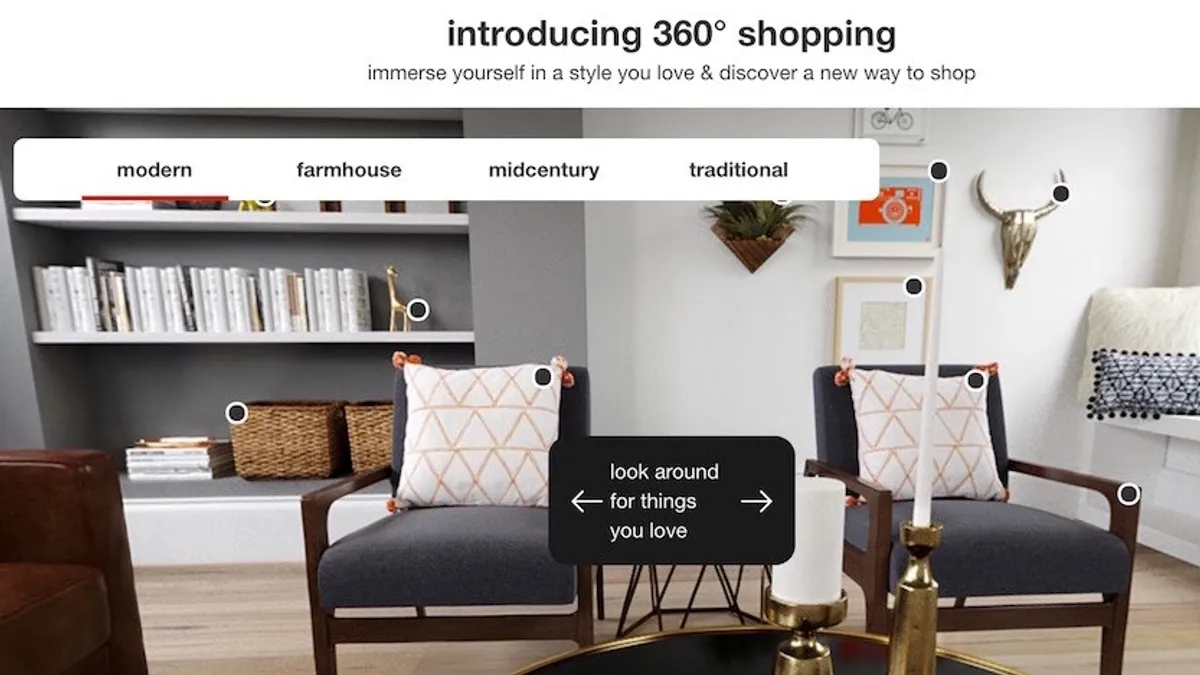Dive Brief:
-
Amazon and Target are taking advantage of surging furniture sales with new policies that make it easier for shoppers to buy furniture and appliances from its websites. Amazon furniture general manager Veenu Taneja told The Wall Street Journal Thursday that the category is one of the fastest-growing and that the e-commerce giant is expanding its assortment.
-
Under a new plan, marketplace furniture sellers set their own pricing, which can vary according to the level of delivery chosen by the Amazon customer. White glove delivery (to a dry room) is the minimum — Amazon won't accept drop-off at the door — but sellers can offer additional services like delivery to a customer's “room of choice,” set-up and haul away.
-
Target on Thursday unveiled a shoppable, 360-degree virtual reality-like experience on its website, featuring curated living room looks in modern, farmhouse, mid-century or traditional styles and the ability to browse some 140 products, including rugs, sofas, wall hangings and decorative throws, in a virtual living room designed to help visualize the size, scale and styling of items, according to a company blog post.
Dive Insight:
Online furniture sales have emerged as a major growth area in e-commerce, rising 18% in 2015, second only to grocery, according to research from Barclays cited by The Wall Street Journal. Some 15% of $70 billion in U.S. furniture sales are now online, according to IBISWorld data cited by the Journal.
Target, Amazon and even Ikea — which has been slow to e-commerce — have joined Wayfair and stalwart Pottery Barn in moving to take advantage of consumers’ openness to shop online for larger and bigger-ticket items. Ikea for years largely eschewed e-commerce, conducting the vast majority of its business through its big-box stores and print catalog. The strategy has slowed the retailer’s overall growth, and after reporting overall online sales growth of just 0.4% in 2014, Ikea pledged to increase e-commerce from about €1 billion per year to at least €5 billion in the next five years, in order to meet its targeted sustained overall growth rate of 10% per year.
For most retailers, fulfillment is becoming a major challenge considering online shoppers expect free or discounted shipping no matter what they buy. Fortunately for furniture retailers, there exists an infrastructure in local areas for delivery because even brick-and-mortar retailers have long shipped to customer homes from furniture manufacturing hubs or their warehouses.
“This is an area where shipping fees can really take a toll because you’re moving furniture,” Jaimee Minney, VP of marketing and public relations at Slice Intelligence, told Retail Dive last year. “The big challenge, unique to e-commerce, is how best to maximize the shipping and handling aspect. When you have gigantic stores you don’t have to think about it as much.”
Amazon already enjoys a 17% market share — and growing — in home furnishings, according to a Morgan Stanley report cited by the Journal. But Wayfair has been a “clear winner of market share” in the countries where it operates, according to a note from Neil Saunders, GlobalData Retail managing director, emailed to Retail Dive in February. Profits have been elusive for the e-commerce furniture and home goods retailer, as it continues to plow revenues into marketing and customer acquisition. First quarter net revenue, consisting of sales generated primarily through Wayfair’s sites, rose 32.1% to $940.4 million, though earnings amounted to a 48 cent-per-share loss, the e-commerce retailer said earlier this month.
Although Target has slimmed down its executive tech teams in recent months, the company appears to be boosting its effort in computer-generated imagery platforms, like the one unveiled Thursday, noting that it’s doubling its team this year and hiring more than 40 CGI experts.
“We’re constantly searching for new ways to inspire our guests and make shopping at Target an easy and inspiring experience,” Target Chief Digital Officer Mike McNamara said in a blog post Thursday. “And we’re just beginning to tap the power of CGI with this virtual reality living room — there’s a ton of potential to create even richer, engaging digital experiences.”













